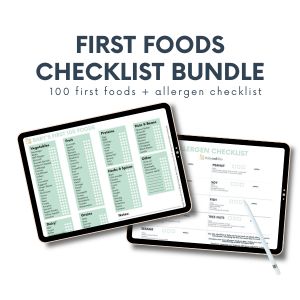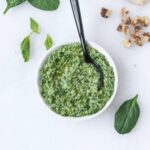Pumpkin is a nutritious first food that can also be convenient to include in your little one's diet. Here is how to serve pumpkin for baby led weaning, including how to cook pumpkin from scratch, how to serve pumpkin puree, and recipe ideas.

I love pumpkin as a first food for babies! If it happens to be in season, roasted pumpkin is a delicious new vegetable for babies to explore. But canned pumpkin puree is also a nutrient-rich addition to baby's diet that is easy to serve year-round. If you've got a little on just starting solids, don't skip this delicious vegetable. Here's everything you need to know about preparing and serving pumpkin to babies using a baby led weaning approach.
Jump to:
When Can Babies Eat Pumpkin?
Babies can eat pumpkin as soon as they are developmentally ready for solids, usually around 6 months. Pumpkin puree is great for both spoon fed and BLW babies, while roasted or steamed pumpkin is better for BLW and finger food stages.
Pumpkin Health Benefits for Babies
Pumpkin is high in several vitamins and minerals, as well as fiber and antioxidants. It is a good source of:
- Fiber - great for digestion and gut health. Pumpkin is a great source of fiber, which can help your little one poop!
- Beta carotene - an antioxidant that is a precursor to vitamin A, it supports the immune system and vision. Pumpkin is VERY high in beta carotene!
- Vitamin K - important for bone health and blood clotting
- Copper - important for growth, formation of neurotransmitters, and transport of iron, among other functions
- Vitamin E - Acts as an antioxidant
- Iron - Important for proper growth and development
Pumpkin also contains several other nutrients in smaller amounts, including vitamin C, B vitamins, potassium and magnesium.
How To Cook Pumpkin From Scratch
I'm sure many of us are familiar with canned pumpkin puree, but have you ever cooked pumpkin from scratch? Pumpkin is a gourd that can be prepared like other winter squash. The best type of pumpkin for cooking is sugar pumpkin, or pie pumpkin, as it will be sweeter and less stringy. Here are a few ways of cooking pumpkin from scratch.

1. Roasted
Cut pumpkin in half and clean out the seeds and stringy bits. Cut into 1-inch wedges with the skin on and toss in oil and any spices (I especially like cinnamon). Spread on a baking sheet and roast in the oven at 400°F until soft, flipping once, anywhere from 15-30 minutes depending on size and age of the pumpkin.
Get a full detailed recipe here: Roasted Pumpkin for Baby Led Weaning
2. Steamed
Cut the pumpkin into 1-inch wedges as described above, either with or without skin. (It is easier to remove skin after cooking.) Place wedges in a steamer basket in a pot of boiling water. The water should not touch the bottom of the basket. Cover and steam until pumpkin is fork tender, about 10-15 minutes.

3. Homemade Pumpkin Puree
First cook the pumpkin. Leave the pumpkin whole and pierce the skin with a sharp knife in several places. Place the pumpkin in a baking dish and roast in the oven at 350°F for about an hour, or until fork tender.
Once cooled, cut the pumpkin into fourths and scoop out the seeds. Scoop the flesh from the skin and place it in a high speed blender or food processor. Blend until smooth.
Get a full detailed recipe here: Homemade Pumpkin Puree
How To Serve Pumpkin For Baby Led Weaning
If you are roasting or steaming fresh pumpkin, some age appropriate options for baby led weaning include:

1. Wedges, with or without skin (6+ months)
For the youngest eaters, larger pieces are better for gripping and bringing to the mouth. Serve roasted or steamed wedges cut about 1 inch thick and at least length of your finger, either with or without the skin. If you leave the skin on, baby will suck or scrape the flesh away and then discard the skin when he is done.
2. Bite sized pieces, no skin (9+ months)
Once baby has developed a pincer grasp, you can cut roasted or steamed pumpkin into bite-size pieces, about the size of your pinky nail, for baby to pick up or practice with utensils.
For serving pumpkin puree, the options are endless, but here are a few favorites:

1. Plain, on a pre-loaded spoon (6+ months)
Load pumpkin puree on a soft spoon and place on baby's tray or hand directly to him to bring to his mouth. Plain pumpkin is not super flavorful, so I'd suggest adding something to spice it up, such as cinnamon or pumpkin pie spice (just no added sugar!).
2. Stirred into oatmeal or yogurt (6+ months)
Pumpkin is great for adding nutrients and flavor to oatmeal or plain Greek yogurt! Serve on a pre-loaded spoon as above. To make a delicious pumpkin yogurt mix, stir equal parts pumpkin puree and plain Greek yogurt with a dash of pumpkin pie spice.
Pumpkin puree can also be stirred into other foods as a thickener or to tame spice, like in chili or soups!
3. Spread on toast fingers or pancakes (6+ months)
Swipe pumpkin puree onto lightly toasted bread fingers or pieces of pancake and sprinkle with cinnamon for a nutritious, sugar-free spread.
Tip: When buying canned pumpkin look for cans without BPA, a toxic substance that can leach into food from the lining of cans.
Of course, you can also use pumpkin puree in many recipes for added nutrients and flavor!

BLW Friendly Pumpkin Recipes
- Roasted Pumpkin For Baby Led Weaning
- Baby Led Weaning Pumpkin Baked Oatmeal (No Added Sugar) (pictured above)
- Pumpkin Pancakes for Baby & Toddler
- Baby Led Weaning Pumpkin Muffins (No Added Sugar)
- Creamy Pumpkin Pasta by Feeding Tiny Bellies
- Slow Cooker Pumpkin Curry by Baby Led Feeding
- Pumpkin Chia Pudding by MJ and Hungryman

Track your baby's journey through starting solids! Get my 100 First Foods Checklist and Allergen Checklist Bundle today!
FAQ
No, pumpkin is not a common allergen. A rash can occasionally occur from skin contact with pumpkin, so be sure to wash up directly after baby eats!
No, cooked pumpkin is not a choking hazard, but the seeds can be! Be sure to remove seeds from cooked pumpkin and always supervise closely anytime baby is eating.
The seeds from fresh pumpkins are too hard and small for baby to eat. If you'd like your baby to try pepitas, or the green pumpkin seeds you see at the store, finely chop them first and sprinkle on top of something, such as oatmeal or yogurt.

















Leave a Reply